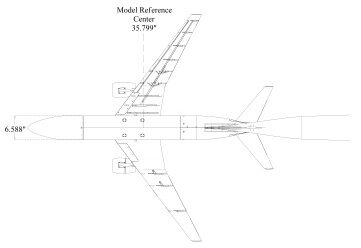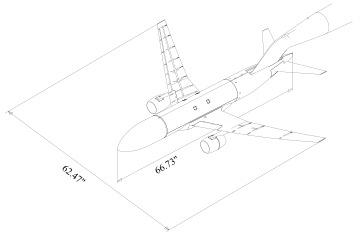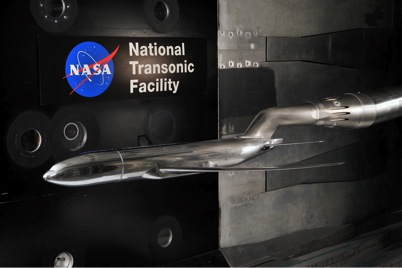The NASA Common Research Model (CRM) consists of a contemporary supercritical transonic wing and a fuselage that is representative of a widebody commercial transport aircraft. The CRM is designed for a cruise Mach number of M∞ = 0.85 and a corresponding design lift coefficient of CL= 0.5.

The aspect ratio is 9.0, the leading edge sweep angle is 35 deg, the wing reference area (S) is 3.011 ft2, the wing span (b) is 62.47 inches, and the mean aerodynamic chord (c) is 7.447 inches. The model moment reference center is located at MS=35.799 inches and WL=4.805 inches. The nacelles used for this test were simple, flow through nacelles.

Pressure distributions are measured on both the left and right wings using 291 pressure orifices located in 9 span-wise wing stations (η = 0.131, 0.201, 0.283, 0.397, 0.502, 0.603, 0.727, 0.846, and 0.950) and on the left hand nacelle by 6 orifices at 6 radial stations (η = 30º, 90º, 150º, 210º, 270º, and 330º). All pressure measurements were made using Electronically Scanned Pressure (PSP) modules mounted inside the forward portion of the fuselage. Based on quoted accuracies from the ESP module manufacturer, surface pressure measurements should be in error no more than +/- 0.015 psi. This in turn would correspond to a variation of no more than +/- 0.0026 in terms of Cp. The model is mounted in the wind tunnel using a blade sting arrangement.
Five different configurations were tested in the current investigation: the wing/body (WB) alone, wing/body/pylon/nacelle (WBPN), wing/body/tail=0° (WBT0), wing/body/tail=+2° (WBT+2) and wing/body/tail=-2° (WBT-2).

